|
History of the Parish (the reproduction of an article by Michael Wynne, in the Furrow)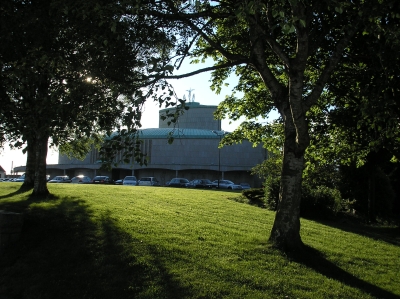
Dundalk has built a new 1,100-seat church, designed by Frank Corr and Oonagh Madden of Derry, to serve a community living in a recently developed suburban area on the west side of the town. It was blessed by Cardinal Conway on Sunday 29th June, 1969.
The church is built on a grassy rise whose granite boundary walls are constructed in Kentish Rag. The form of the building is determined by the elliptical plan of the body of the church; at one end of the shorter axis of the ellipse a smaller ellipse forms the sanctuary and rises well above the nave in a sixty-foot tower. At the opposite end of the same axis is a circular area, constructed to form the entrance-baptistery. This is flanked by two side wings, placed concentrically on the broad side of the main ellipse, and containing sacristies, confessionals and side chapels. The wings and the baptistery are united by an ambulatory which also follows the line of the nave.
The entire concrete shell of the church is sheathed with sawn granite slabs of regular rectangular shape, which give a unity of finish only broken by the large windows, glazed with concrete and glass, dalles-de-verre. The roofs of the tower, nave, and shallow baptistery dome are covered with copper laid in long radial stripes. The top of the tower is decorated with an openwork sculpture of the Crucifixion with the Blessed Virgin Mary and St John, designed and made by Oisin Kelly. The same artist made the ecumenical symbol of the church which will crown the baptistery dome, while Omogen Stuart is the author of the stations of the cross which bring relief to the ambulatory wall. The life-sized linear treatment of the scenes of the Passion are suitable for a public celebration of the Way of the Cross, but aesthetically also have the purpose of drawing down the eye to entrance level, and relieving any possible monotony in the large areas of granite.
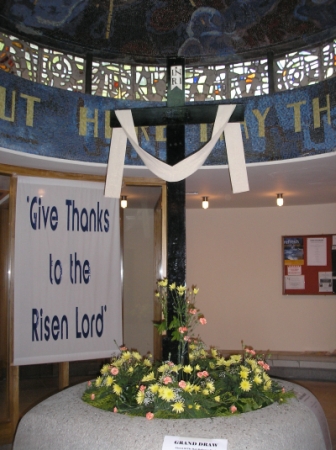 The two main doors of the church are covered with copper sheeting lettered by Frank Morris with translations of Early Christian prayers inspired by the two fundamental doctrines of Baptism and the Eucharist. The hymn of Paulinus of Nola (d. 431) is incised on one of the doors: The two main doors of the church are covered with copper sheeting lettered by Frank Morris with translations of Early Christian prayers inspired by the two fundamental doctrines of Baptism and the Eucharist. The hymn of Paulinus of Nola (d. 431) is incised on one of the doors:
This temple has two porches,
As the Church has two testaments;
But the temple and Church
Are blessed with one fount.
The old law gives strength to the new,
The new completes the old;
In the old was hope,
In the new is faith.
But old and new
Are joined by the grace of Christ:
Which is why a fountain
Has been put in the space between.
The fact that the two doors of the church lead into the baptistery is also echoed in Pauinus’s beautiful hymn. The font is a large granite monolith sculptured by Michael Biggs. Over it is a shallow lantern and dome decorated with stained glass and mosaic by Gabriel Loire. From the baptistery one’s gaze already wanders through the inner glass partition to the sanctuary with its massive altar, the stone of sacrifice of Baptism. Gaining admission through the baptistery, the worshipper is reminded to adopt once more the attitude of death to sin, so that he may advance a little more worthily towards the re-presentation of Calvary and the Last Supper.
Through two doors in the glass partition, one arrives in the great place of assembly of the people of the parish, with the sanctuary clearly becoming the focus of all attention. One has an uninterrupted view of the altar from every position in the church. Because the sacristies are placed at the back of the church the priest approaches the altar in the same way as the faithful. This fact underscores the theological truth that the celebrant is a man chosen among men to minister unto man’s needs in those special things that pertain to God. Celebrating the sacrifice of the Mass facing the people, and bringing Christ to his brothers in the communion banquet, the priest is 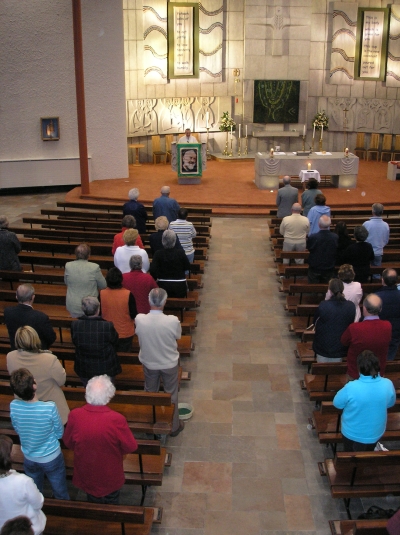 clearly one with the faithful, being united with them in one large elliptical area. clearly one with the faithful, being united with them in one large elliptical area.
The nave is floored with rectangular pieces of South African quartzite, basically a pale grey stone, but showing a variety of tones of brown because of the presence of limonite, or iron hydroxide. Under the floor is the electrical heating mesh. The seats are made of afromosia, while the ceiling is finished with broad slats of parana pine separated to reveal the black hessian backing. The subdued tones of floor, seating, ceiling and stipple-finished walls provide a restrained foil to the three large windows, all made in his studio to the design of Gabriel Loire of Chartres.
The three windows are strictly related to each other in one great abstract symphony of colour. The concrete support to the dalles-de-verre technique and the strong mullions give stability and counterpoint to the rich colour. One notes how the artist has designed the windows to allow for the variety of light throughout the day; the east window has more yellow, orange and red that the south, while the west window is practically devoid of warm tones, because the glow of the setting sun will compensate for their absence. Blue glass in many shades is the basic unifying colour.
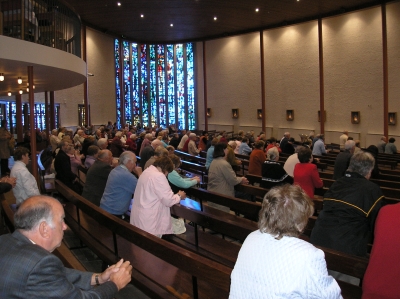 Because of their positions, these windows do not distract attention from the sanctuary. Instead they lend a rich mystical light to the whole interior. The sanctuary itself is lit by two long narrow windows which rise to the height of the tower. The altar, tabernacle, reredos, and ambo were designed and made by Ray Carroll, working to a brief that required him to place the tabernacle in the back wall of the sanctuary, directly behind the altar. The desired dignity of the place of reservation of the Blessed Eucharist is achieved by surrounding the door of the tabernacle with a band of enamel decoration, placed in a granite setting, which itself is the centre of a large decorative reredos. The reredos is lightly carved to portray the apostles, not so much as a realistic picture of the Last Supper as a theme for a slightly richer texture as background to the altar. Because of their positions, these windows do not distract attention from the sanctuary. Instead they lend a rich mystical light to the whole interior. The sanctuary itself is lit by two long narrow windows which rise to the height of the tower. The altar, tabernacle, reredos, and ambo were designed and made by Ray Carroll, working to a brief that required him to place the tabernacle in the back wall of the sanctuary, directly behind the altar. The desired dignity of the place of reservation of the Blessed Eucharist is achieved by surrounding the door of the tabernacle with a band of enamel decoration, placed in a granite setting, which itself is the centre of a large decorative reredos. The reredos is lightly carved to portray the apostles, not so much as a realistic picture of the Last Supper as a theme for a slightly richer texture as background to the altar.
Dundalk’s new church prompts many reflections, but some are perhaps more urgently relevant. It is a large church; the nave is very extensive, and the sanctuary almost equally large in proportion. This means that, despite the strict relationship between all spatial elements, and all furnishings, there is a certain massiveness that raises the scale above the human. Such a scale suitably describes the supernatural element of man’s relationship with God, especially in the act of adoration, but is a less adequate expression of Christ’s solidarity with humanity in the Incarnation, Last Supper and Calvary. It is worthwhile asking oneself whether the large church can ever manage to manifest the latter theological dimension, so much emphasized today.
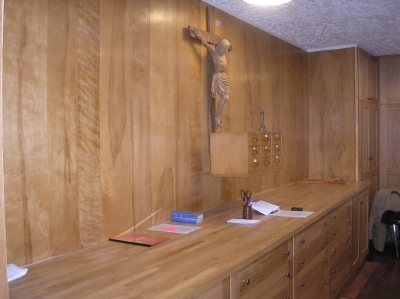 One of the most striking characteristics of the Church of the Redeemer is the splendid harmony that exists between the building and all the necessary adornments. Such a unity lends a dignity, a calm and prayerful mood to the building. It is obvious that the artists commissioned to do the various furnishings were carefully selected because of their potential sympathy with the design, and that they executed their work in close liaison with the architect in charge. Volumes, textures and colours blend in such a way that the building becomes and architectural translation of the Church’s prayer ‘that they may be one’. One of the most striking characteristics of the Church of the Redeemer is the splendid harmony that exists between the building and all the necessary adornments. Such a unity lends a dignity, a calm and prayerful mood to the building. It is obvious that the artists commissioned to do the various furnishings were carefully selected because of their potential sympathy with the design, and that they executed their work in close liaison with the architect in charge. Volumes, textures and colours blend in such a way that the building becomes and architectural translation of the Church’s prayer ‘that they may be one’.
Dundalk’s new Church of the Redeemer commands splendid views north and east, to Slieve Gullion and the Ravensdale hills. On the lower ground to the north is a neatly planned Urban District Council housing scheme; to the east is an area reserved for factory sites, Ecco, Ltd; in the immediate vicinity of the church, in these directions, is an adequate space zoned for low-rise educational buildings. All this development is agreeable, however, to the south and west there is a large area devoted to a private housing, fostered and supported by the local authority, where no control has been exercised on the shape or colour of the individual houses, serviced by a confusing melee of miserably narrow concrete roads. A great opportunity has bee lost to complete what is otherwise a very pleasant suburb, where the foresight of the local and church authorities led to the provision of religious and educational facilities, which are an integral part of the district.
 The Church of the Redeemer, built by Con Creedon and Sons, Ltd., with a team of expert craftsmen and subcontractors, has set a high standard for further development in the area. The quality and durability of the surface finishes have contributed in no small way to the church’s success as practical and beautiful building. The Church of the Redeemer, built by Con Creedon and Sons, Ltd., with a team of expert craftsmen and subcontractors, has set a high standard for further development in the area. The quality and durability of the surface finishes have contributed in no small way to the church’s success as practical and beautiful building.
|
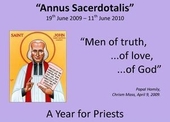


 The two main doors of the church are covered with copper sheeting lettered by Frank Morris with translations of Early Christian prayers inspired by the two fundamental doctrines of Baptism and the Eucharist. The hymn of Paulinus of Nola (d. 431) is incised on one of the doors:
The two main doors of the church are covered with copper sheeting lettered by Frank Morris with translations of Early Christian prayers inspired by the two fundamental doctrines of Baptism and the Eucharist. The hymn of Paulinus of Nola (d. 431) is incised on one of the doors: clearly one with the faithful, being united with them in one large elliptical area.
clearly one with the faithful, being united with them in one large elliptical area. Because of their positions, these windows do not distract attention from the sanctuary. Instead they lend a rich mystical light to the whole interior. The sanctuary itself is lit by two long narrow windows which rise to the height of the tower. The altar, tabernacle, reredos, and ambo were designed and made by Ray Carroll, working to a brief that required him to place the tabernacle in the back wall of the sanctuary, directly behind the altar. The desired dignity of the place of reservation of the Blessed Eucharist is achieved by surrounding the door of the tabernacle with a band of enamel decoration, placed in a granite setting, which itself is the centre of a large decorative reredos. The reredos is lightly carved to portray the apostles, not so much as a realistic picture of the Last Supper as a theme for a slightly richer texture as background to the altar.
Because of their positions, these windows do not distract attention from the sanctuary. Instead they lend a rich mystical light to the whole interior. The sanctuary itself is lit by two long narrow windows which rise to the height of the tower. The altar, tabernacle, reredos, and ambo were designed and made by Ray Carroll, working to a brief that required him to place the tabernacle in the back wall of the sanctuary, directly behind the altar. The desired dignity of the place of reservation of the Blessed Eucharist is achieved by surrounding the door of the tabernacle with a band of enamel decoration, placed in a granite setting, which itself is the centre of a large decorative reredos. The reredos is lightly carved to portray the apostles, not so much as a realistic picture of the Last Supper as a theme for a slightly richer texture as background to the altar. One of the most striking characteristics of the Church of the Redeemer is the splendid harmony that exists between the building and all the necessary adornments. Such a unity lends a dignity, a calm and prayerful mood to the building. It is obvious that the artists commissioned to do the various furnishings were carefully selected because of their potential sympathy with the design, and that they executed their work in close liaison with the architect in charge. Volumes, textures and colours blend in such a way that the building becomes and architectural translation of the Church’s prayer ‘that they may be one’.
One of the most striking characteristics of the Church of the Redeemer is the splendid harmony that exists between the building and all the necessary adornments. Such a unity lends a dignity, a calm and prayerful mood to the building. It is obvious that the artists commissioned to do the various furnishings were carefully selected because of their potential sympathy with the design, and that they executed their work in close liaison with the architect in charge. Volumes, textures and colours blend in such a way that the building becomes and architectural translation of the Church’s prayer ‘that they may be one’. The Church of the Redeemer, built by Con Creedon and Sons, Ltd., with a team of expert craftsmen and subcontractors, has set a high standard for further development in the area. The quality and durability of the surface finishes have contributed in no small way to the church’s success as practical and beautiful building.
The Church of the Redeemer, built by Con Creedon and Sons, Ltd., with a team of expert craftsmen and subcontractors, has set a high standard for further development in the area. The quality and durability of the surface finishes have contributed in no small way to the church’s success as practical and beautiful building.